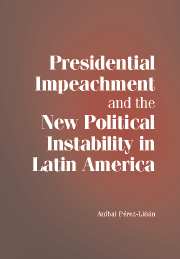Book contents
- Frontmatter
- Contents
- List of Tables and Figures
- Preface and Acknowledgments
- 1 INSTITUTIONAL CRISES IN PRESIDENTIAL REGIMES
- 2 FIVE CASES OF IMPEACHMENT AND A PRESUMED MADMAN
- 3 PRESIDENTIAL CRISES AND THE DECLINE OF MILITARY INTERVENTION
- 4 LATIN AMERICA IN THE AGE OF SCANDAL
- 5 SCANDALS AND THE POLITICAL ECONOMY OF POPULAR OUTRAGE
- 6 BUILDING A LEGISLATIVE SHIELD: THE INSTITUTIONAL DETERMINANTS OF IMPEACHMENT
- 7 TOWARD A NEW PATTERN OF POLITICAL INSTABILITY
- 8 RETHINKING LATIN AMERICAN PRESIDENTIALISM
- References
- Index
- Titles in the series
4 - LATIN AMERICA IN THE AGE OF SCANDAL
Published online by Cambridge University Press: 25 July 2009
- Frontmatter
- Contents
- List of Tables and Figures
- Preface and Acknowledgments
- 1 INSTITUTIONAL CRISES IN PRESIDENTIAL REGIMES
- 2 FIVE CASES OF IMPEACHMENT AND A PRESUMED MADMAN
- 3 PRESIDENTIAL CRISES AND THE DECLINE OF MILITARY INTERVENTION
- 4 LATIN AMERICA IN THE AGE OF SCANDAL
- 5 SCANDALS AND THE POLITICAL ECONOMY OF POPULAR OUTRAGE
- 6 BUILDING A LEGISLATIVE SHIELD: THE INSTITUTIONAL DETERMINANTS OF IMPEACHMENT
- 7 TOWARD A NEW PATTERN OF POLITICAL INSTABILITY
- 8 RETHINKING LATIN AMERICAN PRESIDENTIALISM
- References
- Index
- Titles in the series
Summary
In Chapter 2, I showed that political scandals have been a common denominator in all cases of impeachment. This is not surprising. Fernando Collor was accused by his own brother of managing a broad corruption network; Carlos Andrés Pérez was indicted for embezzlement; Ernesto Samper was charged with accepting campaign donations from the Cali drug cartel; and Raúl Cubas was blamed for defying the Supreme Court and tolerating the assassination of his vice president. Some leaders, like Samper and Cubas, confronted one single major issue throughout their terms. Others, like Collor, Pérez, Bucaram, and González Macchi, found their administrations surrounded by a permanent atmosphere of media scandals that enveloped members of the cabinet, the president's family, and ultimately the chief executive himself.
In fact, these presidents were not alone. This chapter documents a dramatic expansion of political scandals in Latin America in the 1980s and the 1990s, and traces the structural sources of this trend. I account for the growing number of scandals by analyzing the changes that the press was undergoing throughout the region. The combination of political democracy and the development of television networks, the emergence of corporate media groups, and the professionalization of the newsroom has created greater incentives for politicians to use scandal as a political weapon. The chapter illustrates these trends with two contrasting cases: Brazil, where such changes have been dramatic, and Venezuela, where they have been less noticeable but still significant.
- Type
- Chapter
- Information
- Publisher: Cambridge University PressPrint publication year: 2007



